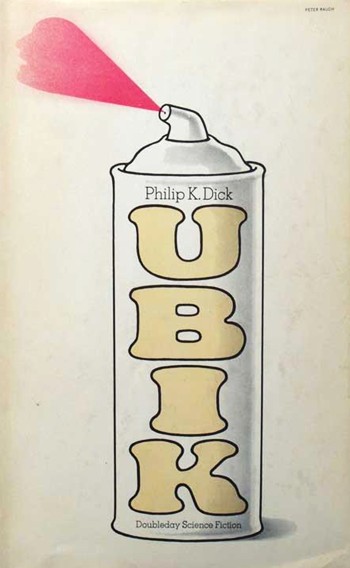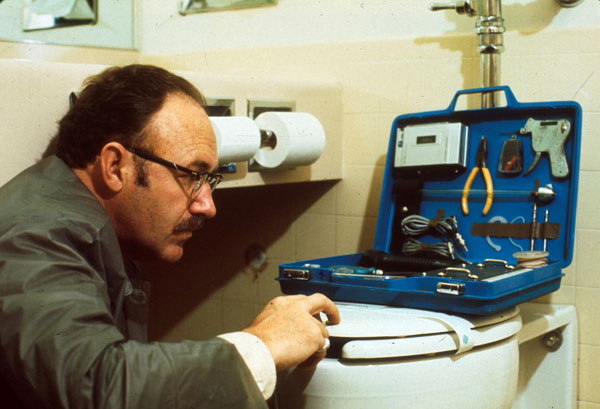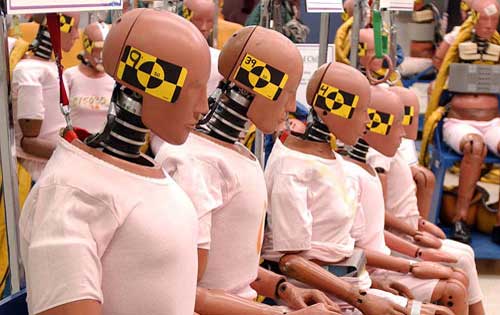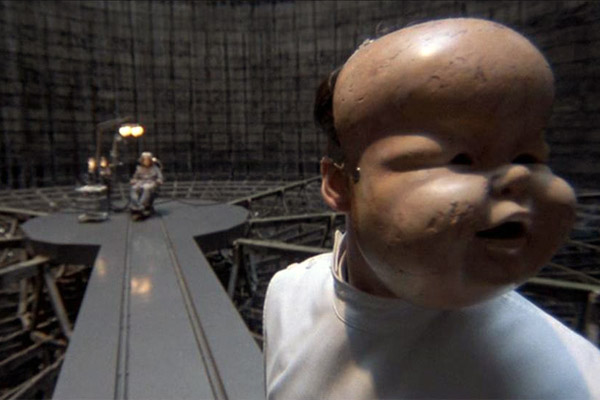Some sort of Italian promotional trailer for Philip K. Dick’s 1969 novel, Ubik.
You are currently browsing the archive for the Science/Tech category.
Tags: Philip K. Dick
So much of this 1969 piece of satirical futurism about the office of tomorrow was spot-on: paper would disappear but so would increasingly the human element. But while it understood what was to come spiritually, it largely missed the mark architecturally. Things would shrink and become portable. We would always be connected. And it was this very connectedness that would mask that alienating effect of it all.
Can there be any shame in a world without secrets? We’re finding out.
Who would have thought that total surveillance wouldn’t just be accepted but welcomed, and that in this one way government and the free market could wholeheartedly agree. William F. Buckley and Senator Edward V. Long discuss our brave new world in 1968, years before Watergate or The Conversation.
Tags: Edward V. Long, William F. Buckley
A hobo did an Ask Me Anything on Reddit. His dream is to create an army of tiny creatures to do his bidding. (And he’s not the only one). An excerpt:
“QUESTION:
ANSWER:
QUESTION:
ANSWER:
Meat production is troubling: It’s responsible for almost 20% of our carbon footprint, animals are treated unethically, the food is largely unhealthy and demand for it from a growing world population may make it scarcer and more expensive. Will we eventually be forced to take the “live” out of livestock? From “Future Foods,” Denise Winterman’s new BBC article, a segment about lab-grown meat:
“Earlier this year, Dutch scientists successfully produced in-vitro meat, also known as cultured meat. They grew strips of muscle tissue using stem cells taken from cows, which were said to resemble calamari in appearance. They hope to create the world’s first ‘test-tube burger’ by the end of the year.
The first scientific paper on lab-grown meat was funded by NASA, says social scientist Dr Neil Stephens, based at Cardiff University’s ESRC Cesagen research centre. It investigated in-vitro meat to see if it was a food astronauts could eat in space.Ten years on and scientists in the field are now promoting it as a more efficient and environmentally friendly way of putting meat on our plates.
A recent study by Oxford University found growing meat in a lab rather than slaughtering animals would significantly reduce greenhouse gases, along with energy and water use. Production also requires a fraction of the land needed to raise cattle. In addition it could be customized to cut the fat content and add nutrients.
Prof Mark Post, who led the Dutch team of scientists at Maastricht University, says he wants to make lab meat ‘indistinguishable’ from the real stuff, but it could potentially look very different. Stephens, who is studying the debate over in-vitro meat, says there are on-going discussions in the field about what it should look like.
He says the idea of such a product is hard for people to take on board because nothing like it currently exists.
‘We simply don’t have a category for this type of stuff in our world, we don’t know what to make of it,’ he says. ‘It is radically different in terms of provenance and product.'” (Thanks Browser.)
••••••••••
“That’s a big chicken”:
Tags: Denise Winterman, Mark Post, Neil Stephens
Architect Nicholas de Monchaux has written about Apollo spacesuits, but how were they described back in the day by BBC reporter James Burke?
Tags: James Burke, Nicholas de Monchaux
Perhaps the most benighted use imaginable of the new technologies was this CueCat promotion from the Einsteins at NBC during the 1990s.
A couple of weeks ago, I posted a piece from Evan R. Goldstein’s Chronicle article about “offshoring” human brains into robot receptacles, effectively immortalizing not only human intelligence but individual personalities as well. It’s a process far beyond cryonics. Ray Kurzweil illuminates the topic further in his blog post “The Strange Neuroscience Of Immortality.” An excerpt about neuroscientist Kenneth Hayworth:
“Before becoming ‘very sick or very old,’ he’ll opt for an ‘early ‘retirement’ to the future,’ he writes. There will be a send-off party with friends and family, followed by a trip to the hospital. After Hayworth is placed under anesthesia, a cocktail of toxic chemicals will be perfused through his still-functioning vascular system, fixing every protein and lipid in his brain into place, preventing decay, and killing him instantly.
Then he will be injected with heavy-metal staining solutions to make his cell membranes visible under a microscope. All of the water will then be drained from his brain and spinal cord, replaced by pure plastic resin.
Every neuron and synapse in his central nervous system will be protected down to the nanometer level, Hayworth says, ‘the most perfectly preserved fossil imaginable.’
Using a ultramicrotome (like one developed by Hayworth, with a grant by the McKnight Endowment Fund for Neuroscience), his plastic-embedded preserved brain will eventually be cut into strips, and then imaged in an electron microscope. The physical brain will be destroyed, but in its place will be a precise map of his connectome.
In 100 years or so, Hayworth says, scientists will be able to determine the function of each neuron and synapse and build a computer simulation of the mind. And because the plastination process will have preserved his spinal nerves, the computer-generated mind can be connected to a robot body.”
••••••••••
Howard Stern investigates cryonics and the fate of Ted Williams’ frozen head:
Tags: Baba Booey, Evan R. Goldstein, Howard Stern, Ray Kurzweil
From a 1994 Wilson Quarterly article about Americans settling the virtual Wild West, which shows just how far we’ve come, at least technologically:
“Some futurists see the germ of the 21st century in today’s nascent ‘on-line’ services, such as America Online, Prodigy, and CompuServe. Pay a membership fee and dial up one of these services using a modem attached to your personal computer, and you can catch up on the news, check your mutual fund investments, and chat with like-minded folks on bulletin boards devoted to such specialized topics as your hometown hockey team, office etiquette, opera, or nuclear proliferation. But so far the services have attracted only a specialized clientele of affluent, highly educated, gadget-oriented users. The total subscriber base of these three top on-line services stands at less than three million, smaller than the subscriber base of Newsweek. At America Online, the hottest of the services, the largest number of pioneers actually traveling in cyberspace at any one time is only about 8,000.”
••••••••••
A decade earlier, AT&T wondered about the Information Superhighway:
At the Philosopher’s Beard, an essay about the penal system thinks very far outside the box, suggesting less incarceration and more flogging and execution. A hard sell, to be sure. But the piece has a good passage about criminal nature, which follows:
“Even if someone has committed a serious crime and deserves to be punished severely, that does not necessarily mean that they present a danger we need to be protected from. Corporate fraudsters for example can be made safe relatively easily by removing their rights to manage companies. Likewise even those who commit very serious violent crimes may not be particularly dangerous; for example women who kill abusive husbands do not go around killing other people. Quite often, people are sentenced to prison for the worst thing they have ever done, and not for being dangerous. Thus, little to no security benefits are achieved from their stay in prison. Of course there are people whose character can be said to be criminal, and who do present a risk to society for as long as they are free, but these are a small minority of those who are now sent to prison. The way we use prison now assumes that all convicts are criminal characters, which is not only false, but a very inefficient way of trying to achieve security.” (Thanks Browser.)
With 3D printers in the offing, guns aren’t likely going anywhere and far more dangerous things are probably upon us. From Mark Gibbs at Forbes:
“Given the recent appalling events in Aurora, Colorado, there’s been a renewed call for greater gun control and a ban on assault weapons.
I’m in favor of tighter gun control and a ban on weapons that are unnecessarily powerful but I’m afraid that technology will soon make any legislation that limits the availability of any kinds of guns ineffective.
To understand why this might happen, you need to understand a technology called 3D printing.
3D printing allows you to build things that are, as the name implies, three dimensional. A few years ago 3D printers were very rare, hugely expensive, and hard to use. But as with anything that can be driven by computers, 3D printers has become cheaper and cheaper to the point where, today, you can buy a 3D printer, off the shelf, for as little $500.
Using either free or low cost computer aided drafting software you can create digital 3D models of pretty much anything you can think of and, with hardly any fuss, your 3D printer will render them as physical objects.”
Tags: Mark Gibbs
Olympic ceremonies, now routinely treated like blockbusters and “directed” by leading filmmakers, began to grow in size and proportion when the Games were staged in 1984 (with the help of a UFO) at the home of Hollywood.
The opening of an argument by Julian Savulescu and Ingmar Persson at Philosophy Now in favor of using bioenhancement to develop human morality:
“For the vast majority of our 150,000 years or so on the planet, we lived in small, close-knit groups, working hard with primitive tools to scratch sufficient food and shelter from the land. Sometimes we competed with other small groups for limited resources. Thanks to evolution, we are supremely well adapted to that world, not only physically, but psychologically, socially and through our moral dispositions.
But this is no longer the world in which we live. The rapid advances of science and technology have radically altered our circumstances over just a few centuries. The population has increased a thousand times since the agricultural revolution eight thousand years ago. Human societies consist of millions of people. Where our ancestors’ tools shaped the few acres on which they lived, the technologies we use today have effects across the world, and across time, with the hangovers of climate change and nuclear disaster stretching far into the future. The pace of scientific change is exponential. But has our moral psychology kept up?
With great power comes great responsibility. However, evolutionary pressures have not developed for us a psychology that enables us to cope with the moral problems our new power creates. Our political and economic systems only exacerbate this. Industrialisation and mechanisation have enabled us to exploit natural resources so efficiently that we have over-stressed two-thirds of the most important eco-systems.
A basic fact about the human condition is that it is easier for us to harm each other than to benefit each other.” (Thanks Browser.)
Tags: Ingmar Persson, Julian Savulescu
From the 1964 Messenger Lecture Series at Cornell, Richard Feynman delivers a speech called “The Character of Physical Law: The Distinction Between Past and Future.”
Tags: Richard Feynman
Our phones are smarter than us now, and soon our cars will be as well. From an explanation of intelligent mobility by Jamie Carter at Tech Radar:
“Intelligent mobility describes any technology that increases transport network capacity while also reducing accidents and pollution. It’s largely about collaboration, about creating both cars and cities that can communicate with each other, and react accordingly.
It starts with a car dashboard that knows about upcoming traffic jams in advance and automatically re-plots a route to avoid it, perhaps taking into account congestion zone charges.
And it reaches its zenith when cars automatically change speed to avoid each other, with the idea of ‘platooning’ when the lead car at traffic lights literally sets the exact pace of all cars behind – all networked and communicating in real-time – in an effort to get more cars through junctions as quickly as possible.
Humans losing control of their own vehicles is a distant memory in the dreams of transport planners, and while no world city is anywhere near that point, some are distinctly ‘smarter’ than others.”
Tags: Jamie Carter
Hugh Pearman’s Wall Street Journal piece, “These Knock-Down, Shrinkable Games,” looks at the transient structures that are making the London Games fiscally sensible. It reminded me that wooden insta-stadia capable of seating 50,000 to 100,000 were routinely built in a couple of months nearly a century ago for major prizefights. They were razed soon after the bout. Tex Rickard built just such a momentary edifice for Jack Dempsey’s defense of the heavyweight title against Georges Carpentier on July 2, 1921. Two excerpts follow, one from Pearman and one about the ’21 Dempsey fight stadium:
From Pearman’s WSJ piece: “Some hankered after a flashier stadium to rival Beijing’s, but a firm policy was established once the bid was won in 2005: Mindful of the legacy of neglect common among many earlier Olympic-host cities, no white-elephant buildings were allowed for London. This was to be the knock-down Games: Venues with no obvious long-term future—such as the Olympic Stadium—were designed to be dismantled entirely, while others were to be shrinkable once the huge audiences for the Games dispersed.”
From the April 26, 1921 New York Times: “Although the plot embraces thirty-four acres the particular land Rickard has contracted for includes only about six-and-one-half acres. Upon this stretch of ground the promoter will erect his giant arena with its proposed seating capacity of over 50,000. The start will be made on the arena just as soon as the ground is levelled. Rickard expects that the arena will be completed within fifty days, without rushing the workmen or necessitating overtime. It is estimated that 100 carloads of lumber will be used in its construction.”
••••••••••
Great footage of the stadium at the outset of this video:
Tags: Georges Carpentier, Hugh Pearman, Jack Dempsey, Tex Rickard
Architect Moshe Safdie became a sensation while in his twenties when his Habitats tiny-box buildings wowed the world at Expo ’67 in Montreal. He landed on the cover of Newsweek just a few years later. John Heilpern recently interviewed Safdie for a Vanity Fair piece, revealing him to be something of a Method architect. An excerpt:
“While his own work can be spectacular, Mr. Safdie’s school of architecture amounts to an artless art when compared with the showy geometry of the fashionable starchitect. He’s constantly asking what the purpose of a building actually is—as his early mentor, Louis I. Kahn, once asked, ‘What does a building want to be?’
‘We live in a complicated, oppressive world with enormous cities and vast populations, and I try to contribute by making it more light and open and calm,’ Mr. Safdie said. ‘I try firstly to make buildings humane. Countries and places have a history, a story, and a culture. I want my buildings to take root and look as if they’ve always been there.’
It’s why, when he designed the Khalsa Heritage Centre, in the Indian holy city of Anandpur Sahib, he studied the Sikh religion for two years and wanted the contemporary museum to look as if it had been built 300 years ago.
‘It isn’t about pastiche or adapting what’s already there,’ he added. ‘It’s about trying to blend the future and the past.’
He has seen the future and it doesn’t always work. Soulless malls masquerading as new village squares, glass-box skylines, Trump taste, postmodern froufrou, and the Bilbao effect are all anathema to him.”
Tags: John Heilpern, Moshe Safdie
I would guess bio-printers will eventually make organ scarcity a problem of the past, but until that occurs should people be allowed to sell their organs? Moral philosopher Janet Radcliffe Richards has long argued that the trade, while unsettling, should be permitted. An excerpt from her reasoning:
I find trade in organs as intuitively repugnant as does everyone else but strong feelings of a moral kind, by themselves, cannot form reliable guides for action. Remember the traditional reactions to inter-racial marriage, unfeminine women and homosexuality – themselves now widely regarded as repugnant? If we find the trade repugnant because of the harm it does to vendors, we must find the idea of making their situation worse by stopping the trade more repugnant. The worse we think it is to sell a kidney, the more repugnant should we find any objectively worse alternative. We should find it much more repugnant that the Turkish father should be forced to keep his kidney and watch his daughter die than that he should sell it and save her. We should also find our repugnance proportionately lessened if we could assure high standards of care that would make the harm minimal.
This does not prove conclusively that organ sales should be allowed; good arguments for prohibition may still be found. The fact that so many bad arguments are used, however, shows that good ones must be hard to come by, and it also suggests that our strong feelings of repugnance are systematically distorting our arguments. We are in effect treating the removal of our own feelings of disgust as more important than the real interests of the people on whose behalf we claim to be concerned. It is therefore morally essential to understand the power of these feelings so that we can think impartially about the problem.
In the meantime, until someone produces a far better argument than has yet appeared, there seems to be no escaping the provisional conclusion that the prohibition of the sale of organs does substantial harm of various sorts, that these have not been shown to be justified and therefore that we should not be trying to prevent the selling of organs but rather to lessen whatever harms are now involved and to increase the benefits to both vendors and purchasers by getting the trade properly regulated.•
Tags: Janet Radcliffe Richards
Sad to hear of the passing of pioneering female astronaut Sally Ride. I haven’t been able to find any footage of her you haven’t seen a million times already, but here’s a 1977 clip of some of the other women who were vying for the distinction that Ride eventually earned.
Tags: Ann Whittaker, Caroline Griner, Mary Johnston, Sally Ride
From the Economist, an explanation of the Uncanny Valley Effect, which tries to explain human unease with examples of AI that seem real and unreal at once:
“ARTIFICIALLY created beings, whether they be drawn or sculpted, are warmly accepted by viewers when they are distinctively inhuman. As their appearances are made more real, however, acceptance turns to discomfort until the point where the similarity is almost perfect, when comfort returns. This effect, called ‘the uncanny valley’ because of the dip in acceptance between clearly inhuman and clearly human forms, is well known, particularly to animators, but why it happens is a mystery. Some suggest it is all about outward appearance, but a study just published in Cognition by Kurt Gray at the University of North Carolina and Daniel Wegner at Harvard argues that there can be something else involved as well: the apparent presence of a mind where it ought not to be.
According to some philosophers the mind is made up of two parts, agency (the capacity to plan and do things) and experience (the capacity to feel and sense things). Both set people apart from robots, but Dr Gray and Dr Wegner speculated that experience in particular was playing a crucial role in generating the uncanny-valley effect. They theorised that adding human-like eyes and facial expressions to robots conveys emotion where viewers do not expect emotion to be present. The resulting clash of expectations, they thought, might be where the unease was coming from.”
••••••••••
Facial motion test of AI baby:
Tags: Daniel Wegner, Kurt Gray
Augmented catalog by the Swedish manufacturer of furniture and meatballs. (Thanks Wired.)
President Richard Nixon phoned the Apollo 11 astronauts while they were on the moon. Unsurprisingly, the call was taped.
McCandless: …We’d like to get both of you in the field-of-view of the camera for a minute. (Pause) Neil and Buzz, the President of the United States is in his office now and would like to say a few words to you. Over.
Armstrong: That would be an honor.
McCandless: Go ahead Mr. President. This is Houston out.
Nixon: Hello, Neil and Buzz. I’m talking to you by telephone from the Oval Room at the White House. And this certainly has to be the most historic telephone call ever made. I just can’t tell you how proud we all are of what you’ve done. For every American, this has to be the proudest day of our lives. And for people all over the world, I am sure they too join with Americans in recognizing what an immense feat this is. Because of what you have done, the heavens have become a part of man’s world. And as you talk to us from the Sea of Tranquility, it inspires us to redouble our efforts to bring peace and tranquility to Earth. For one priceless moment in the whole history of man, all the people on this Earth are truly one: one in their pride in what you have done, and one in our prayers that you will return safely to Earth.
Armstrong: Thank you Mr. President. It’s a great honor and privilege for us to be here, representing not only the United States, but men of peace of all nations, and with interest and curiosity, and men with a vision for the future. It’s an honor for us to be able to participate here today.
Nixon: And thank you very much and I look forward – all of us look forward – to seeing you on the Hornet on Thursday.
Armstrong: Thank you.
Aldrin: I look forward to that very much, sir.•
Tags: Richard
The opening of Esther Dyson’s new Project Syndicate essay, which suggests we should apply the self-quant movement to communities:
“I have written previously about the Quantified Self movement – individuals equipped with the tools (monitoring devices and software) needed to measure their own health and behavior (and, by doing so, to improve them). This movement is not quite sweeping the world, but it is making a difference. So-called Quantified Selfers are monitoring their blood pressure, sleep cycles, and body mass. At least some of them are using that information to improve their health and live more productively.
In the same way, I predict (and am trying to foster) the emergence of a Quantified Community movement, with communities measuring the state, health, and activities of their people and institutions, thereby improving them. Just consider: each town has its own schools, library, police, roads and bridges, businesses, and, of course, people. All of them potentially generate a lot of data, most of it uncollected and unanalyzed. That is about to change.” (Thanks Browser.)
••••••••••
Early quantified community, 1977:
Tags: Esther Dyson
From the “3000 A.D.” section of FutureTimeline.net, which predicts the far-flung:
“Purely biological humans are typically 7ft tall now, with lifespans of 120+
For centuries now, the technological singularity has produced enormous wealth and prosperity throughout the solar system. Across-the-board improvements in healthcare, education and living standards have led to humans evolving into a race of giants – 7ft tall, muscular and highly athletic, with lifespans of 120+. Note that this lifespan refers to purely biological (non-cyborg) humans, who comprise a small minority by now. The vast majority of citizens have opted for genetic engineering and biotechnology upgrades which offer practical immortality”























